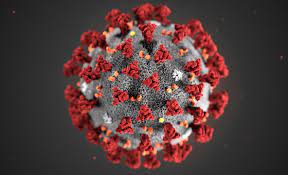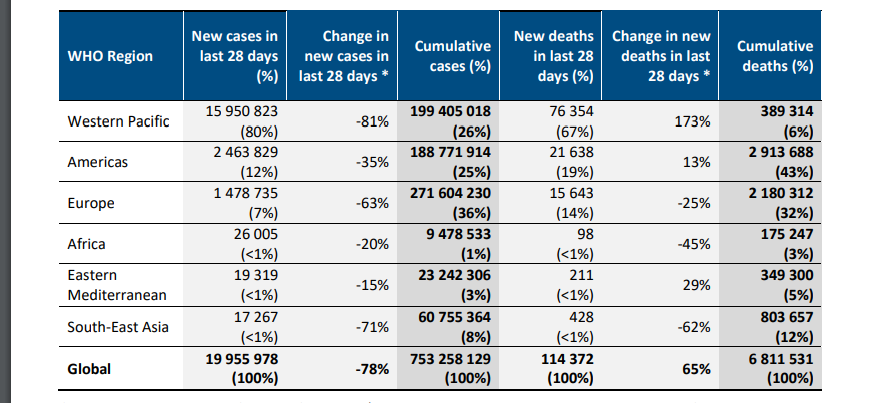
-
Published: 05 February 2023

EDITED BY |CHRISTIAN MEGAN
5- FEB.-2023- WHO
In Feb. month WHO published its new report on coronavirus covid 19.
The report said nearly 20 million new cases and over 114 000 deaths were reported in the last 28 days (2 to 29 January 2023), a decrease of 78% and an increase of 65%, respectively, compared to the previous 28 days. As of 29 January 2023, over 753 million confirmed cases and over 6.8 million deaths have been reported globally.
From this report onwards, we present changes in epidemiological trends using a 28-day interval. This helps to smooth out weekly fluctuations in case numbers and provides a clearer picture of where the pandemic is accelerating or decelerating.
At the regional level, the number of newly reported 28-day cases decreased across all WHO regions:
the Western Pacific Region (-81%), the South-East Asia Region (-71%), the European Region (-63%), the Region of the Americas (-35%), the African Region (-20%), and the Eastern Mediterranean Region (-15%). The number of newly reported 28-day deaths increased across three regions: the Western Pacific Region (+173%), the Eastern Mediterranean Region (+29%), and the Region of the Americas (+13%). Death numbers decreased in three WHO regions: the South-East Asia Region (-62%), the African Region (-45%), and the European Region (-25%). At the country level, the highest numbers of new 28-day cases were reported from China (11 354 058 new cases; -85%), Japan (3 207 097 new cases; -20%), the United States of America (1 513 538 new cases; -16%), the Republic of Korea (1 032 801 new cases; -43%), and Brazil (459 986 new cases; -54%). The highest numbers of new 28-day deaths were reported from China (62 759 new deaths; +244%), the United States of America (14 625 new deaths; +31%), Japan (10 122 new deaths; +46%), the United Kingdom (3137 new deaths; -3%), and Brazil (2889 new deaths; -24%).

Geographic spread and prevalence Globally, from 30 December 2022 to 30 January 2023, 90 985 SARS-CoV-2 sequences were shared through GISAID. Among these, 90 937 sequences were the Omicron variant of concern (VOC), accounting for over 99.9% of sequences reported globally in the past 30 days. At the global level, BA.5 and its descendent lineages remain dominant. In epidemiological week 2 (9 to 15 January 2023) they accounted for 65.7% (with 16 357 sequences) of all submitted sequences to GISAID. The prevalence of BA.2 and its descendent lineages was 14.6% (3645 sequences), while BA.4 and its descendent lineages were 0.3% (68 sequences). The top three variants globally in January 2023 were BQ.1.1 (28.2%), BQ.1 (14.1%), and XBB.1.5 (11.5%). BQ.1.1 and BQ.1 are BA.5 descendent lineages, while XBB.1.5 is a BA.2 descendent recombinant lineage. Variant circulation dynamics differ by WHO region and among countries within the same region due to a variety of factors, including previous circulating variants, vaccination coverage, and implemented public health and social measures. During January 2023, the top three most prevalent variants in each region were as follows: • Africa (332 sequences): BQ.1.1 (23.7%), BA.2.10.1 (12.3%), and XBB.2 (12.1%); • Americas(40 010 sequences): BQ.1.1 (37.5%), XBB.1.5 (19.6%), and BQ.1 (19.6%); • Eastern Mediterranean (85 sequences): XBB.1 (37.2%), BN.1 (10.3%), and BA.5.2 (10.3%); • Europe (40 379 sequences): BQ.1.1 (31.3%), BQ.1 (13.0%), and CH.1.1 (12.3%); • South-East Asia (389 sequences): XBB.1 (41.1%), BQ.1.1 (14.3%), and BA.2.10.1 (6.0%); • Western Pacific (15 515 sequences): BA.5.2 (30.1%), BF.7 (13.2%), and BQ.1.1 (8.5%). WHO is currently prioritizing the tracking of four Omicron descendent lineages. These variants are included on the basis of signals of an increase in prevalence or signs of growth rate advantage in some countries relative to other circulating variants, and additional amino acid changes that are known or suspected to confer fitness advantage. During epidemiological week 2, 1147 sequences of BF.7 (4.6%), 11 674 sequences of BQ.1* (46.9%), including BQ.1.1 (7189 sequences, 28.9%) were reported. There were 3473 sequences of BA.2.75* (13.9%), including BA.2.75.2 (35 sequences, <1%) and CH.1.1 (1672 sequences, 6.7%). Lastly, 4049 sequences of XBB* (16.3%), including XBB.1.5 (3005 sequences, 12.1%), were submitted globally to GISAID.
